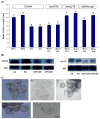RNA interference directed against ribosomal protein S3a suggests a link between this gene and arrested ovarian development during adult diapause in Culex pipiens
- PMID: 19863669
- PMCID: PMC2824042
- DOI: 10.1111/j.1365-2583.2009.00926.x
RNA interference directed against ribosomal protein S3a suggests a link between this gene and arrested ovarian development during adult diapause in Culex pipiens
Abstract
Arrested ovarian development is a key characteristic of adult diapause in the mosquito Culex pipiens. In this study we propose that ribosomal protein S3a (rpS3a), a small ribosomal subunit, contributes to this shutdown. RpS3a is consistently expressed in females of C. pipiens that do not enter diapause, but in females programmed for diapause, expression of the rpS3a transcript is dramatically reduced for a brief period in early diapause (7-10 days after adult eclosion). RNA interference directed against rpS3a in nondiapausing females arrested follicle development, mimicking the diapause state. The effect of the dsRNA injection faded within 10 days, allowing the follicles to grow again, thus the suppression of rpS3a caused by RNAi did not permanently block ovarian development, implying that a brief suppression of rpS3a is not the only factor contributing to the diapause response. The arrest in development that we observed in dsRNA-injected females could be reversed with a topical application of juvenile hormone III, an endocrine trigger known to terminate diapause in this species. Though we speculate that many genes contribute to the diapause syndrome in C. pipiens, our results suggest that a shut down in the expression of rpS3a is one of the important components of this developmental response.
Figures





Similar articles
-
A potential role for ribosomal protein S2 in the gene network regulating reproductive diapause in the mosquito Culex pipiens.J Comp Physiol B. 2010 Feb;180(2):171-8. doi: 10.1007/s00360-009-0406-9. Epub 2009 Sep 23. J Comp Physiol B. 2010. PMID: 19774386
-
A shut-down in expression of an insulin-like peptide, ILP-1, halts ovarian maturation during the overwintering diapause of the mosquito Culex pipiens.Insect Mol Biol. 2009 Jun;18(3):325-32. doi: 10.1111/j.1365-2583.2009.00872.x. Insect Mol Biol. 2009. PMID: 19523064 Free PMC article.
-
Insulin signaling and FOXO regulate the overwintering diapause of the mosquito Culex pipiens.Proc Natl Acad Sci U S A. 2008 May 6;105(18):6777-81. doi: 10.1073/pnas.0802067105. Epub 2008 Apr 30. Proc Natl Acad Sci U S A. 2008. PMID: 18448677 Free PMC article.
-
Suppression of allatotropin simulates reproductive diapause in the mosquito Culex pipiens.J Insect Physiol. 2014 May;64:48-53. doi: 10.1016/j.jinsphys.2014.03.005. Epub 2014 Mar 20. J Insect Physiol. 2014. PMID: 24657669 Free PMC article.
-
Evidence that microRNAs are part of the molecular toolkit regulating adult reproductive diapause in the mosquito, Culex pipiens.PLoS One. 2018 Nov 29;13(11):e0203015. doi: 10.1371/journal.pone.0203015. eCollection 2018. PLoS One. 2018. PMID: 30496183 Free PMC article.
Cited by
-
Comparative 4D Label-Free Quantitative Proteomic Analysis of Bombus terrestris Provides Insights into Proteins and Processes Associated with Diapause.Int J Mol Sci. 2023 Dec 26;25(1):326. doi: 10.3390/ijms25010326. Int J Mol Sci. 2023. PMID: 38203496 Free PMC article.
-
Transcriptional Dynamics Induced by Diapause Hormone in the Silkworm, Bombyx mori.Biology (Basel). 2022 Sep 4;11(9):1313. doi: 10.3390/biology11091313. Biology (Basel). 2022. PMID: 36138792 Free PMC article.
-
Reduction in Musca domestica fecundity by dsRNA-mediated gene knockdown.PLoS One. 2018 Jan 17;13(1):e0187353. doi: 10.1371/journal.pone.0187353. eCollection 2018. PLoS One. 2018. PMID: 29342168 Free PMC article.
-
Oral delivery of double-stranded RNA in larvae of the yellow fever mosquito, Aedes aegypti: implications for pest mosquito control.J Insect Sci. 2013;13:69. doi: 10.1673/031.013.6901. J Insect Sci. 2013. PMID: 24224468 Free PMC article.
-
Transcriptome characterization analysis of Bactrocera minax and new insights into its pupal diapause development with gene expression analysis.Int J Biol Sci. 2014 Sep 12;10(9):1051-63. doi: 10.7150/ijbs.9438. eCollection 2014. Int J Biol Sci. 2014. PMID: 25285037 Free PMC article.
References
-
- Bowen MF, Davis EE, Haggar DA. A behavioral and sensory analysis of host-seeking behavior in the diapausing mosquito Culex pipiens. J Insect Physiol. 1988;34:805–813.
-
- Byrom M, Pallotta V, Brown D, Ford L. Visualizing siRNA in Mammalian cells: Fluorescence analysis of the RNAi effect. Ambio TechNotes. 2002;9:68.
-
- Christophers SR. The development of the egg follicle in Anophelines. Paludism. 1911;1:73–88.
-
- Coetzee T, Herschlag D, Belfort M. Escherichia coli proteins, including ribosomal protein S12, facilitate in vitro splicing of phage T4 introns by acting as RNA chaperones. Genes Dev. 1994;8:1575–1588. - PubMed
-
- Cui K, Coutts M, Stahl J, Sytkowski AJ. Novel interaction between the transcription factor CHOP (GADD153) and the ribosomal protein FTE/S3a modulates erythropoiesis. J Biol Chem. 1998;275:7591–7596. - PubMed
Publication types
MeSH terms
Substances
Grants and funding
LinkOut - more resources
Full Text Sources
Other Literature Sources

